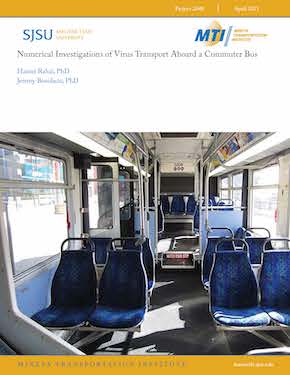- 408-924-7560
- mineta-institute@sjsu.edu
- Donate
Numerical Investigations of Virus Transport Aboard a Commuter Bus
The authors performed unsteady numerical simulations of virus/particle transport released from a hypothetical passenger aboard a commuter bus. The bus model was sized according to a typical city bus used to transport passengers within the city of Long Beach in California. The simulations were performed for the bus in transit and when the bus was at a bus stop opening the middle doors for 30 seconds for passenger boarding and drop off. The infected passenger was sitting in an aisle seat in the middle of the bus, releasing 1267 particles (viruses)/min. The bus ventilation system released air from two linear slots in the ceiling at 2097 cubic feet per minute (CFM) and the air was exhausted at the back of the bus. Results indicated high exposure for passengers sitting behind the infectious during the bus transit. With air exchange outside during the bus stop, particles were spread to seats in front of the infectious passenger, thus increasing the risk of infection for the passengers sitting in front of the infectious person. With higher exposure time, the risk of infection is increased.
One of the most important factors in assessing infection risk of respiratory diseases is the spatial distribution of the airborne pathogens. The deposition of the particles/viruses within the human respiratory system depends on the size, shape, and weight of the virus, the morphology of the respiratory tract, as well as the subject’s breathing pattern. For the current investigation, the viruses are modeled as solid particles of fixed size. While the results provide details of particles transport within a bus along with the probable risk of infection for a short duration, however, these results should be taken as preliminary as there are other significant factors such as the virus’s survival rate, the size distribution of the virus, and the space ventilation rate and mixing that contribute to the risk of infection and have not been taken into account in this investigation.
HAMID RAHAI, PhD
Dr. Hamid Rahai is a professor in the Departments of Mechanical and Aerospace Engineering & Biomedical Engineering and the Associate Dean for Research and Graduate Studies in the College of Engineering at California State University, Long Beach (CSULB). He has taught various classes at the undergraduate and graduate levels in the areas of fluid dynamics, thermodynamics, heat transfer, instrumentation, numerical methods, and turbulence. He has supervised over 80 M.S. theses and projects and Ph.D. dissertations and has published more than 90 technical papers. He has received more than 10 million dollars in grants and contracts from the National Science Foundation, Federal Highway Administration, California Energy Commission, California Air Resources Board, Port of Los Angeles, Caltrans, Boeing Company, Southern California Edison, Long Beach Airport, and Long Beach Transit, among others. He has been granted a patent for the development of a high-efficiency vertical axis wind turbine (VAWT) and another with Via Verde Company on wind turbine apparatuses. He also has pending patents on a new conformal vortex generator tape for reducing wing-tip vortices, and one based on previous MTI-funded research for reducing NOx emissions of gas-powered engines using a humid air system. For the past 26 years, he has been a consultant to local energy and aerospace industries. Dr. Rahai is the recipient of several scholarly and creative activities awards (RSCA), including the 2012 CSULB Impact Accomplishment of the Year in RSCA Award, the 2002–2003 CSULB Distinguished Faculty RSCA Award, the 2004 Northrop Grumman Excellence in Teaching Award, and a 2005–06 Merit of Scholarship Award by the Southern California Chapter of the American Society of Heating, Refrigerating and Air Conditioning Engineers (ASHRAE). In 2014, Dr. Rahai received the Outstanding Engineering Educator Award from the Orange County Engineering Council in California, and in 2019 he was inducted as a senior member of the National Academy of Inventors (NAI).
JEREMY BONIFACIO, PhD
Dr. Jeremy Bonifacio is a recent PhD graduate from the doctoral program in Engineering and Computational Mathematics, offered jointly between the CSULB College of Engineering and the Claremont Graduate University (CGU). He is a teaching professor and a research associate at the Center for Energy and Environmental Research & Services (CEERS) in the College of Engineering at California State University, Long Beach. He has been involved in various projects at CEERS related to emission control technologies and mitigations along with various aerodynamics and indoor air quality projects. He is the winner of the 2014 CSULB innovation challenge, co-owner of two provisional patents, and author of ten technical publications. Dr. Bonifacio’s expertise is in experimental and computational fluid mechanics.
-
Contact Us
San José State University One Washington Square, San Jose, CA 95192 Phone: 408-924-7560 Email: mineta-institute@sjsu.edu






